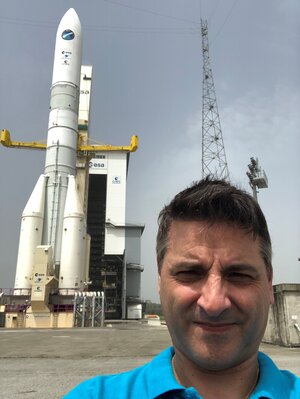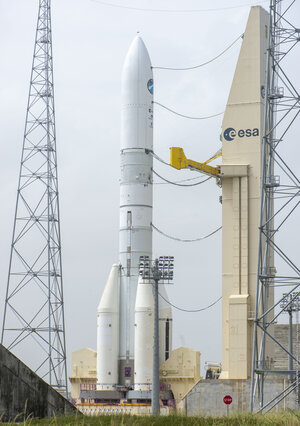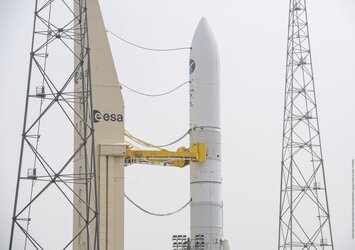Accept all cookies Accept only essential cookies See our Cookie Notice

About ESA
The European Space Agency (ESA) is Europe’s gateway to space. Its mission is to shape the development of Europe’s space capability and ensure that investment in space continues to deliver benefits to the citizens of Europe and the world.
Highlights
ESA - United space in Europe
This is ESA ESA facts Member States & Cooperating States Funding Director General Top management For Member State Delegations European vision European Space Policy ESA & EU Space Councils Responsibility & Sustainability Annual Report Calendar of meetings Corporate newsEstablishments & sites
ESA Headquarters ESA ESTEC ESA ESOC ESA ESRIN ESA EAC ESA ESAC Europe's Spaceport ESA ESEC ESA ECSAT Brussels Office Washington OfficeWorking with ESA
Business with ESA ESA Commercialisation Gateway Law at ESA Careers Cyber resilience at ESA IT at ESA Newsroom Partnerships Merchandising Licence Education Open Space Innovation Platform Integrity and Reporting Administrative Tribunal Health and SafetyMore about ESA
History ESA Historical Archives Exhibitions Publications Art & Culture ESA Merchandise Kids Diversity ESA Brand Centre ESA ChampionsLatest
Space in Member States
Find out more about space activities in our 23 Member States, and understand how ESA works together with their national agencies, institutions and organisations.
Science & Exploration
Exploring our Solar System and unlocking the secrets of the Universe
Go to topicAstronauts
Missions
Juice Euclid Webb Solar Orbiter BepiColombo Gaia ExoMars Cheops Exoplanet missions More missionsActivities
International Space Station Orion service module Gateway Concordia Caves & Pangaea BenefitsLatest
Space Safety
Protecting life and infrastructure on Earth and in orbit
Go to topicAsteroids
Asteroids and Planetary Defence Asteroid danger explained Flyeye telescope: asteroid detection Hera mission: asteroid deflection Near-Earth Object Coordination CentreSpace junk
About space debris Space debris by the numbers Space Environment Report In space refuelling, refurbishing and removingSafety from space
Clean Space ecodesign Zero Debris Technologies Space for Earth Supporting Sustainable DevelopmentLatest
Applications
Using space to benefit citizens and meet future challenges on Earth
Go to topicObserving the Earth
Observing the Earth Future EO Copernicus Meteorology Space for our climate Satellite missionsCommercialisation
ESA Commercialisation Gateway Open Space Innovation Platform Business Incubation ESA Space SolutionsLatest
Enabling & Support
Making space accessible and developing the technologies for the future
Go to topicBuilding missions
Space Engineering and Technology Test centre Laboratories Concurrent Design Facility Preparing for the future Shaping the Future Discovery and Preparation Advanced Concepts TeamSpace transportation
Space Transportation Ariane Vega Space Rider Future space transportation Boost! Europe's Spaceport Launches from Europe's Spaceport from 2012Latest
Ariane 6 cryogenic disconnection systems pass key tests
Thank you for liking
You have already liked this page, you can only like it once!
ESA’s new Ariane 6 heavy-lift rocket is a critical step closer to inaugural launch, following completion of tests to validate launch pad/launcher systems that will keep the vehicle topped up with liquid hydrogen and liquid oxygen in the critical moments before liftoff.
While on the launch pad at Europe’s Spaceport in French Guiana, Ariane 6 relies on a “cryogenic connection system” of umbilical cords carrying its hydrogen and oxygen fuel – liquified at -250C and -180C respectively – as well as helium and nitrogen used for flushing and purging. The tests seen in this video showed that retraction times and mechanical loads meet design expectations for the system which feeds the core stage. Similar tests of the upper stage system were completed earlier.
ESA Launch System Architect Engineer Franck Saingou says: “The great novelty of Ariane 6 is that those connections to the ground systems are released at liftoff. This close timing demands a very carefully synchronised movement of the connection systems, but there are great advantages.
“By remaining connected to the rocket until just a few seconds before liftoff, this system allows us to more easily drain the tanks in the event of an aborted launch.” Last-moment disconnection simplifies preparations for the next launch attempt, improving availability of Ariane 6.
And, adds Saingou, this system does away with some of the ‘purging lines’ needed by Ariane 5 – which reduces recurring costs and the dry mass of the rocket.
Daniel Neuenschwander, ESA’s Director of Space Transportation, emphasised the significance of these tests. “Ground systems are as important as the rocket itself, and it is critical that both work together as a precision system to deliver the game-changing performance we expect from Ariane 6.
“Ariane 6 marks a new era in reliable, competitive and autonomous European spaceflight, and I am delighted to see our teams in Europe and French Guiana making solid progress.”
-
CREDIT
ESA/CNES/Arianespace -
LICENCE
ESA Standard Licence
-
Closed captions available Captions and subtitles are available (automatically generated by YouTube) - select your language using the YouTube player controls. A non-YouTube version is available using the 'download' button above.
-
Documentary
-
-
-
-
-

Franck and Ariane 6 test model

Ariane 6 test model cryogenic system disconnection

Ariane 6 test model during fuel line disconnection test

Franck at Ariane 6 launch zone















 Germany
Germany
 Austria
Austria
 Belgium
Belgium
 Denmark
Denmark
 Spain
Spain
 Estonia
Estonia
 Finland
Finland
 France
France
 Greece
Greece
 Hungary
Hungary
 Ireland
Ireland
 Italy
Italy
 Luxembourg
Luxembourg
 Norway
Norway
 The Netherlands
The Netherlands
 Poland
Poland
 Portugal
Portugal
 Czechia
Czechia
 Romania
Romania
 United Kingdom
United Kingdom
 Slovenia
Slovenia
 Sweden
Sweden
 Switzerland
Switzerland

























